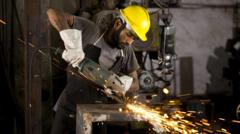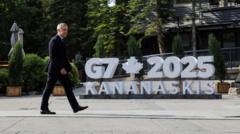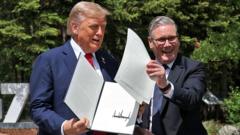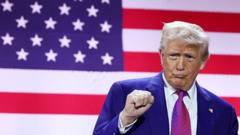India's economy is under scrutiny as it reports a disappointing GDP growth of 5.4% for the July-September quarter, marking a seven-quarter low that falls short of the Reserve Bank of India’s (RBI) expectations. Even though it remains stronger than many developed nations, this decline raises concerns about a possible slowdown. Experts attribute this troubling trend to several intertwined issues, including weakened consumer demand, sluggish private investment, and reduced government spending, which has been vital in propelling the economy forward. Additionally, India’s goods exports continue to lag with a global share of only 2% in 2023, further contributing to the downturn.
Is India's Economic Growth Trajectory Slowing Down?

Is India's Economic Growth Trajectory Slowing Down?
India’s latest GDP figures indicate a potential loss of momentum in its economic growth, challenging its title as the fastest-growing large economy.
Fast-moving consumer goods (FMCG) companies have reported lackluster sales, while data suggests that urban wage growth has stagnated. The RBI, once optimistic, has revised its growth projection down to 6.6% for the upcoming financial year. Despite Finance Minister Nirmala Sitharaman’s optimistic outlook, asserting that the decline is non-systematic and merely a seasonal adjustment due to election activities, economists like Rajeshwari Sengupta emphasize the impending demand crisis.
Inflation, a growing concern, surged to 6.2% in October, primarily driven by escalating vegetable prices, impacting household expenses and overall economic confidence. Critics argue that high-interest rates, aimed at controlling this inflation, have hindered both business borrowing and consumer spending—key components for economic growth. While the RBI continues to focus on inflation control, observers note a paradox; high levels of borrowing for retail credit suggest individuals are turning to credit to sustain consumption, but urban demand remains lackluster compared to a more favorable rural landscape buoyed by a good monsoon cycle.
The ongoing economic landscape presents a clear division: an old economy comprising small-scale industries and agriculture muddled by delayed reforms, and a new economy thriving on certain service sectors, particularly those tied to global outsourcing trends. India has positioned itself as the largest hub for global capability centers (GCCs) that cater to high-end service demands. However, as patterns evolve, the earlier surge in urban consumption is diminishing, leaving the old economy in dire need of revitalization.
High tariffs have complicated matters further, increasing from 5% in 2013-14 to 17% today, which demands higher costs for exporters and diminishes global competitiveness. The RBI’s ongoing efforts to support the rupee amidst slipping forex reserves also restrict liquidity—another factor dampening growth.
Economists stress the necessity for comprehensive reforms to spur private investment, push exports, and generate job creation. Key recommendations include raising wages through government-run initiatives and reducing tariffs to become a viable alternative for manufacturers seeking to relocate from China.
Although the Indian government projects confidence in resilience, the conversation surrounding sustainable economic growth remains complex. As skeptics highlight the gap between the ambitious narrative and actual job and income generation, experts like Sengupta emphasize the urgent need for tangible actions to manifest the much-talked-about growth story of India, urging that while headlines tout progress, concrete steps remain essential for realizing potential.
Inflation, a growing concern, surged to 6.2% in October, primarily driven by escalating vegetable prices, impacting household expenses and overall economic confidence. Critics argue that high-interest rates, aimed at controlling this inflation, have hindered both business borrowing and consumer spending—key components for economic growth. While the RBI continues to focus on inflation control, observers note a paradox; high levels of borrowing for retail credit suggest individuals are turning to credit to sustain consumption, but urban demand remains lackluster compared to a more favorable rural landscape buoyed by a good monsoon cycle.
The ongoing economic landscape presents a clear division: an old economy comprising small-scale industries and agriculture muddled by delayed reforms, and a new economy thriving on certain service sectors, particularly those tied to global outsourcing trends. India has positioned itself as the largest hub for global capability centers (GCCs) that cater to high-end service demands. However, as patterns evolve, the earlier surge in urban consumption is diminishing, leaving the old economy in dire need of revitalization.
High tariffs have complicated matters further, increasing from 5% in 2013-14 to 17% today, which demands higher costs for exporters and diminishes global competitiveness. The RBI’s ongoing efforts to support the rupee amidst slipping forex reserves also restrict liquidity—another factor dampening growth.
Economists stress the necessity for comprehensive reforms to spur private investment, push exports, and generate job creation. Key recommendations include raising wages through government-run initiatives and reducing tariffs to become a viable alternative for manufacturers seeking to relocate from China.
Although the Indian government projects confidence in resilience, the conversation surrounding sustainable economic growth remains complex. As skeptics highlight the gap between the ambitious narrative and actual job and income generation, experts like Sengupta emphasize the urgent need for tangible actions to manifest the much-talked-about growth story of India, urging that while headlines tout progress, concrete steps remain essential for realizing potential.






















